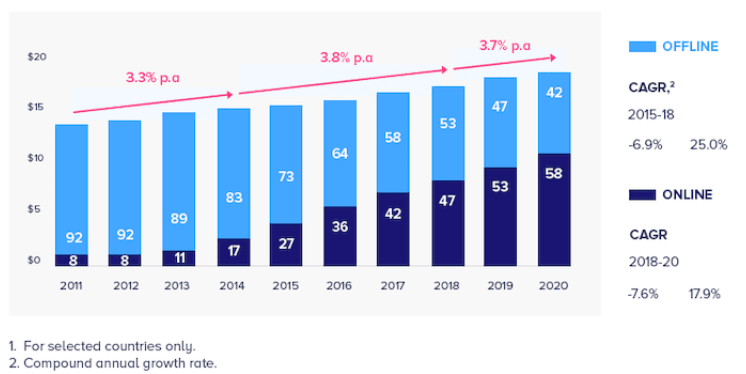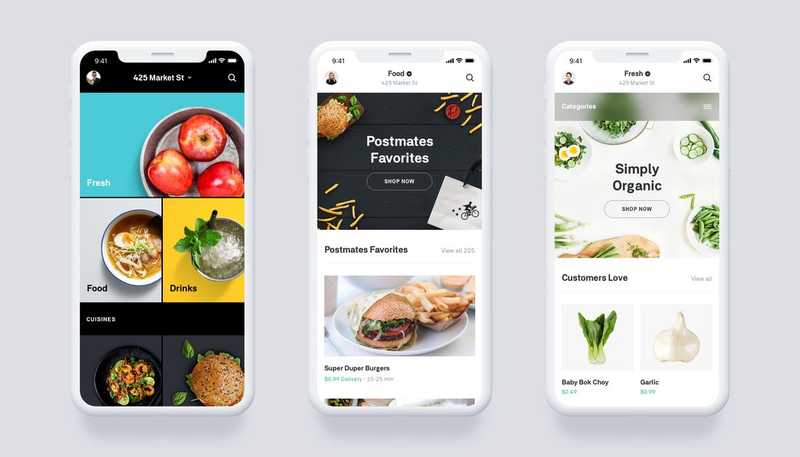Why Do Food Delivery Startups Fail? Discussing Challenges, Strategies, and Solutions
Lately, we’ve been discussing how to develop a food ordering and delivery app. But developing a mobile app is only half the problem. Typically, several challenges come with maintaining a food delivery application. Today, we’re going to take a closer look at these challenges
The growing food delivery market
We’ve already talked about developing a food delivery mobile application.
Now let’s dive deeper into this field and explore the food delivery market.
Based on data from Statista, in 2019 the total revenue of the online food industry was $107,400 million. Statista’s projection for 2023 shows that revenue will grow to $156,819 million.

Let’s face it: nobody is surprised by this. The number of people choosing to order in is increasing. In fact, 47% of the food ordering market is offline, while 53% is online. But as the demand for food delivery apps increases, food delivery businesses are also facing some serious challenges.
Here’s a list of companies that are quite successful in the food delivery business right now:
- Postmates
- Chick-fil-A
- DoorDash
- McDonald’s
- Starbucks
- Uber Eats
Today, we’ll discuss seven challenges that food delivery apps will face in the next years to come.
Top business models of food delivery apps
There are two major types of business models in food delivery — some startups create their own delivery fleets, while others prefer to outsource this task to specialized delivery companies. Both approaches have their pros and cons, so let’s talk about them.
If you choose to partner with a delivery company, you free yourself from all the hassle associated with hiring delivery staff, and maintaining their delivery equipment, and more. However, with that, you lose all control over the delivery. While your service and application can be flawless, delivery can make or break the whole customer experience. There are lots of problems faced by food delivery companies that are connected with poor delivery.
If you decide to build your own fleet, you’ll need to manage it, but on the other hand, you’ll be in control of its quality, and this may be more important than saving efforts on hiring and managing people.
Challenges faced by online food delivery apps
Poor UX design in a food delivery app
If users have any issues while they’re trying to order food, they’ll likely abandon an app and go to your competitors, that’s why it’s so important to make your application focused on user experience.
Solution: Discovery phase services allow you to define your goals, find your positioning in the market compared to your competitors, and also work on your user experience based on market research. After a discovery phase, you’ll get a full blueprint of your future app, from UI/UX designs and wireframes to technical documentation and information about your target market, audience and competitors.
Get an example of the Discovery Phase documentation for your digital project
Disloyal customers
The food delivery market is hot, and it’s extremely hard to turn customers into regulars and keep them around. Customers can simply lose interest in your app or find another app that provides more options or faster delivery. Businesses that don’t focus on maintaining a regular customer base can suffer in the long term.
Solution: So, how to prevent your food delivery startup from problems with food delivery services? There’s so much you can do. First of all, you can add more options to your app. Customers love selection, and if you don’t have a restaurant they want on your list, they’re likely to switch to another app. Treat regular customers with freebies, special deals, and discounts. You can even add a cashback system to your app. If you make your customers feel special, they’ll be loyal.
Industry giants
The online food delivery market is growing and has great potential. But with the arrival of big beasts like Uber Eats and Amazon Restaurant, getting market share will be hard for startups. Big companies have all the resources needed to capture the majority of the market, causing independent food delivery startups to fail. People are more likely to trust a familiar name like Amazon than to give a chance to an unknown startup.
Solution: You’ll have to come up with something that your competitors don’t have. It can be an interesting feature or a UI/UX that differentiates your product. For example, you can make your app social media friendly so customers have information on what others are ordering and what’s trending in the restaurant world.
Inconsistent user experience
Sometimes food delivery startups are failing due to inconsistent user experience. Food delivery apps represent a variety of restaurants and cafes. Sometimes it’s hard to pack information about all of them into a consistent and convenient package. All screens of a mobile application should be in the same style, with a consistent UI/UX throughout.
Solution: Hire a good mobile app development company to build an application that will be appealing to users and offer a consistent design and experience across all app screens.
Unreliable delivery
Unreliable delivery is a problem that often bothers customers. Nobody likes when their food arrives late and cold. So why does it happen? Reasons include traffic, order volume, low wages, lack of training, and lack of employee benefits. This problem is an important one to solve because it can lead to customers leaving your app. Also, restaurants don’t like when their food is presented in a negative way.
Solution: To solve issues with late delivery, add comprehensive driver performance metrics and detailed order histories to your driver app. Such features will help drivers analyze their performance and improve their productivity.
Logistics issues
Food delivery mobile apps face some serious challenges when it comes to logistics:
- Choosing a coverage area
- Determining the number of vehicles needed
- Keeping food fresh when delivering to far-off destinations
As you can see, there are a number of concerns that should be dealt with. You should ensure on-time delivery to keep your customers.
Solution: To ensure that food is delivered on time, it’s a good idea to add a route optimization system to your mobile application. For example, you can use the Routific API to solve this issue.
Also, keep your customers updated on the order location by adding real-time location tracking to your mobile food delivery application.
Large order volumes
When a food delivery business is going well, one problem it can come across is a huge volume of orders. Startups usually focus on an immersive user interface and performance that takes them to the next level, but they don’t know how to manage all the orders. This leads to increased delivery times and compromises food quality.
Solution: The most obvious solution is to get more contractors to deliver food. But first, you need to calculate the demand. Use data analytics tools to analyze data and determine when demand will grow.
Food quality
The quality of food is a major concern for food delivery businesses. With food delivery, there’s always a risk of poor packaging or spillage. This can happen if couriers aren’t careful or if restaurants don’t pack food correctly.
Food served in a restaurant right from the kitchen is a different experience from food delivered to your doorstep.
Solution: To solve this problem, require training to become a delivery agent and use the right packaging to deliver food. You can give your restaurant partners standards for food packaging. Also, you can implement a rewards system into your app not only for couriers but for restaurants.
Another interesting solution can be to use the latest technologies like the blockchain. A blockchain can be used to make digital contracts to track orders and give customers their money back in case of food delivery issues. Thanks to blockchain technology, customers can research restaurants and even suppliers. A blockchain also can be used to verify driver’s licenses.
Challenges Postmates had to face
Sometimes startups in the food delivery business fail because of the lack of attention to competitors’ issues.
Do big food delivery apps have problems too? Let’s find out what challenges Postmates has faced.
Price discrepancies and unhappy customer
Some time ago, Postmates was blamed for misleading prices. Several users complained that the estimate in the cart didn’t agree with the actual price when the orders were delivered. With a required delivery fee and a 9% service fee, some users paid twice as much as the price is initially shown. Let’s find out how such a misunderstanding could happen.
Apps like Postmates charge users service fees because of the need to spend big money on marketing, wages, etc. This is normal for this kind of app. The problem is that these fees are sometimes not that minor. For example, the service fees in Postmates can easily add up to more than $10 per order.
Even though people are ready to pay more for the convenience of takeout, the difference between estimates and final costs can disappoint customers and turn them away. This is what happened to Postmates.
The difference between estimates and final costs can disappoint customers and turn them away.
After the accusations, Postmates tried to explain what happened and how these strange differences between estimates and final prices can occur. It turned out that when customers order from merchants that are not official Postmates partners, the fee is higher. Postmates explained that the prices are typically on target when it comes to restaurants that are part of Postmates’ special Merchant Program.
To learn from this case, always give users complete information on fees. It would be a good idea to explain all fees when a user places an order.
Misrepresenting restaurant brands
Postmates provides delivery in different fields, but its specialty is restaurant delivery. Postmates uses Foursquare systems to power restaurant search.
But there’s a catch: once a restaurant’s address is entered into the Postmates search engine, it’s added automatically to the Postmates system, meaning that restaurants can be featured in the app without joining the Merchant Program. Some restaurants are not happy with this feature, because once a restaurant is added it can’t be deleted.
Restaurant owners are not only unhappy with Postmates delivering their food without their knowledge. They’re also worried that Postmates misrepresents their brands.

Anand Dass, Postmates’ business development director, stated that Postmates’ primary focus is its customers. The problem is that a customer-centered approach isn’t the most suitable for an app with multiple stakeholders: customers, restaurants, and couriers.
From Postmates’ mistakes, we can learn that the success of a food delivery platform is based on strong and trusting relationships between the service and restaurants.
Restaurant owners are unhappy with Postmates delivering their food without their knowledge. They’re also worried that Postmates misrepresents their brands.
Remember to give restaurants a choice as to whether they will use your delivery service. When drawing up contracts with restaurants, discuss the best way to market their products, suggest choosing items off the menu that travel well, and discuss packaging, areas of delivery, etc.
Solutions to improve your food delivery app
We’ve shared some of the challenges food delivery apps may face and provided you with solutions.
Here’s bonus information that will help you improve your food delivery business.
- Most business problems can be solved with the right marketing. Reach out to your customer base and spread the word about your services in a way your target audience appreciates.
- Regularly test your app, and not just its code, but its UX as well. Test new approaches to your service, and make sure your app is relevant from the user experience standpoint. Outdated design can cause your users to turn to your competitors.
- The market changes constantly. Businesses either evolve or die, so make sure you don’t get behind the trends.
- Fast online support can put your food delivery app above others and improve customer communication and feedback.
- Separate reviews and ratings for food and delivery services. If the delivery itself was great but the food wasn’t, or vice versa, it’s best to know that. This way you can show honest ratings to your customers.
- Include diversity in your service. Uber has a different model for different services like food, alcohol, and grocery delivery. You can follow Postmates and make your platform an all-in-one solution.
- Be unique. Make sure that your app like Postmates or Uber Eats is not an exact replica. Come up with an idea that will make you stand out in the crowd.
- Use machine learning. For starters, marketing your food delivery app as a machine learning-powered solution will bring you attention because of the popularity of machine learning. But most importantly, you can use machine learning to display the right kind of restaurant to the right users. University students likely won’t be interested in ordering food from a Michelin star restaurant. And Wall Street bankers probably won’t be interested in ordering food from a local pizza place. Machine learning can help you display a list of places on the home page based on a user’s preferences and past behavior.
Machine learning can help you display a list of places on the home page based on a user’s preferences and past behavior.
Conclusion
Food delivery mobile applications have a bright future, full of new opportunities. In this article, I talked about why food delivery startups fail. The food delivery industry faces challenges like disloyal customers, industry giants, inconsistent user experiences, unreliable delivery, logistics issues, handling large volumes of orders, and ensuring food quality.
Make sure that your food delivery app has lots of options, provide discounts and freebies for loyal customers, and add driver metrics to track delivery driver performance. Remember to always inform your customers of the fees your app is charging. And don’t forget that using technologies like machine learning and the blockchain can distinguish you from your competitors.


